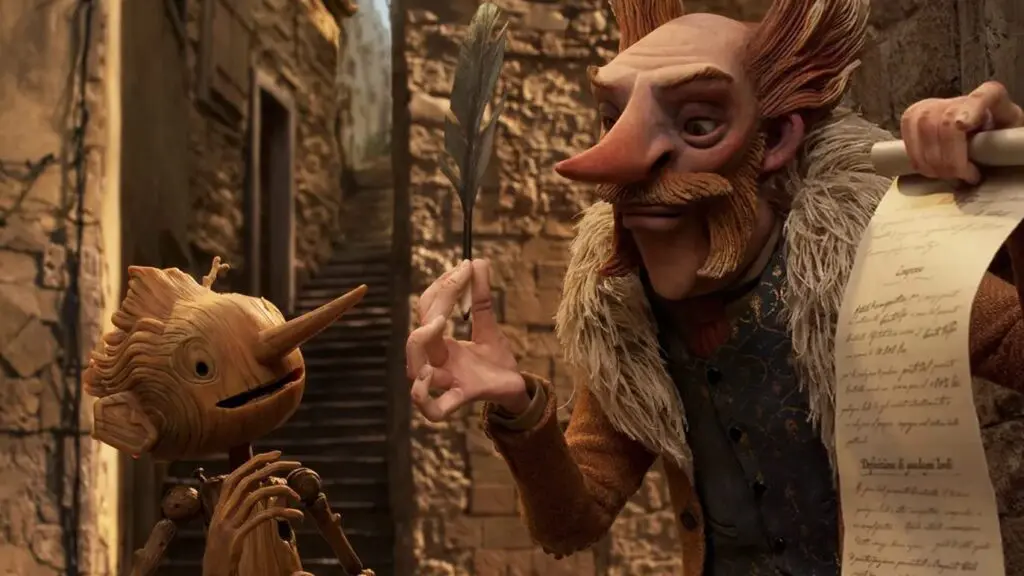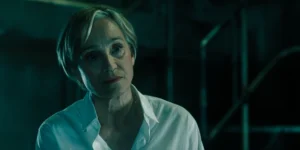We discuss the ending of the Netflix Guillermo del Toro’s Pinocchio, which will contain spoilers.
Geppetto loses Carlo during an accidental bombardment of a church restoration during Benito Mussolini’s fascist leadership. And as you know, how the story goes, Geppetto makes a father’s desperate wish to magically bring a wooden boy to life in Italy—giving him a second chance to father the young boy. The question, though, is what does Geppetto carve Pinocchio out of? He carves him out of the tree that grew out of Carlo’s grave. Of course, like any young boy, boys are put on earth to make their fathers worry or cause trouble. (Tip your hat to Paul Newman in Road to Perdition for that one). Of course, why wouldn’t Geppetto worry? He had already lost Carlo, and Italy was now a dangerous place ruled under a fascist thumb.
And that’s essentially the theme in Pinocchio. A tale of fathers and sons. While Gepetto is worried about his new wooden boy for most of the film (and in other source materials, including the original), there is the theme of his disapproval and another father figure who consistently watches over him — The Talking Cricket (Ewan McGregor). You will notice it is Sebastian (his first name per IMDB) who is guiding and teaching Pinocchio the ways of the world and how to function in it, not Geppetto.
You can even argue the theme that Geppetto sees Pinocchio as something to give him joy, where The Talking Cricket is the nurturing parent. Throughout the film, The Talking Cricket tries to keep singing a song his father would sing to him. An expression of his own fatherhood and takes place in a time and era of living in the “Fatherland,” which spread from Germany to Italy.
Eventually, Geppetto’s expectations for Pinocchio are too much for the young wooden boy to reach. He runs off, worrying. Like the Talking Cricket, Geppetto and his new friends search for him. This leads to Geppetto’s life being put in danger. Of course, Pinocchio attempts to save him. As a result, Pinocchio is killed. Have no fear; Cricket has one wish to give. He then brings our beloved wooden boy back to life. This is a change to the story, excepting Pinocchio for who he is; instead of Geppetto wanting his new son to be someone else, he can be who he is destined to be.
“What happens, happens, and then we are gone,” is the line Cricket says. Why? Let’s explain. Of course, Guillermo del Toro’s Pinocchio examines those unintended consequences that the Disney version fails to go. For example, after Pinocchio comes back to life, the story doesn’t just stop there. Of course, as life goes on, others pass away. Soon we see graves for Geppetto and Cricket dug next to Carlo’s. Cricket, who is still narrating, then says that famous line.
Pinocchio then goes off into the world.
Guillermo del Toro’s Pinocchio ending explained
The ending of the film has a mid-credits scene. (Sorry, guys, there is no post-credits surprise in this version of Pinocchio). The Talking Cricket sings a song with a handful of rabbits (or “hares”). In the background, Crickett is playing cards with the rabbits. They ask him if he will keep playing cards or start singing that song. He throws his hand down and tells them to hit it. Cricket then begins to belt out the words. One that he sang with his father.
Why is this significant? This is the song Cricket has been trying to sing all film long and kept getting cut off by life’s circumstances. One could argue it sets up a joke, but now that the Cricket has passed on and Pinocchio is out in the real world by himself, his job as a parent is done, and now he gets to enjoy the afterlife in peace. In the source material, Rabbits signify death, as Rabbits carried a black coffin into the room to take him away.
The rabbits in this version represent not death but the joy of life.
What did you think of the ending of the Netflix film Guillermo del Toro’s Pinocchio? Comment below.
More Stories
- Guillermo del Toro’s Pinocchio review
- Is Guillermo del Toro’s Pinocchio kid friendly?




